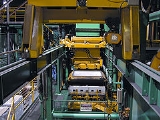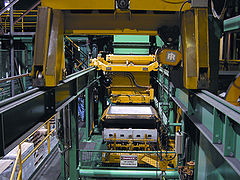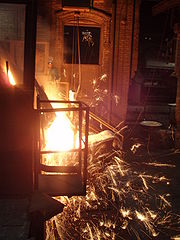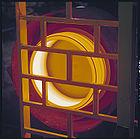
Goldens' Foundry
Encyclopedia
Goldens' Foundry and Machine Co. is a privately held
ductile iron
and gray iron
foundry
with headquarters in Columbus, Georgia
and additional facilities in Cordele, Georgia
in the United States
. It has operated continuously since 1882. Goldens' provides castings to a variety of industries, including agricultural, construction, power transmission, defense, and large vehicles.
Goldens' is still owned and operated by descendants of the original three founders. George Golden Boyd, Sr., president and CEO, and John Thomas Boyd, Jr., vice president of sales, continue to lead the family-run company to this day. Likewise, George Boyd's three sons, George Jr., Ed, and John have assumed primary roles in administration, operations, and sales.
The foundry went through numerous upgrades, growing into a 150000 sq ft (13,935.5 m²) facility. With integrated core
, molding, cleaning, and machining, and finishing facilities under one roof, Goldens' is able to provide a single-source resource to casting consumers.
Goldens' employs more than 200 skilled workers at their Columbus location, and approximately 40 at their newer operation in Cordele.
Quality Assurance
Goldens' utilizes numerous techniques to ensure quality is maintained at both facilities. The company is ISO 9001-2000
certified by Lloyd's. Lean manufacturing
principles are also in place throughout the facility, and 5S standards are in place in each department.
 In Columbus, Casting operations in Goldens’ are supported by four Brown-Boveri coreless induction furnaces, coupled with 1200°F (650°C) preheating, and a comprehensive core shop employing isocure, shell
In Columbus, Casting operations in Goldens’ are supported by four Brown-Boveri coreless induction furnaces, coupled with 1200°F (650°C) preheating, and a comprehensive core shop employing isocure, shell
and no-bake (air set). Steel and quality scrap are purchased from a variety of sources.
The goal with a tight-flask machine such as this is to create near net-shape castings, reducing the need for machining and other processing operations.

 Goldens' utilizes a specific centrifugal cast
Goldens' utilizes a specific centrifugal cast
operation for adding iron liners to steel drums. In Goldens’ centrifugal casting process, molten iron is poured into a hollow cylindrical mold spinning on a horizontal or vertical axis at speeds generating 40 to 70 Gs of centrifugal force. This force distributes the molten metal, promotes directional solidification
, and improves casting integrity by forcing impurities to the inside surface.
Centrifugal casting
at Goldens' is designed for specific product applications, as opposed to other foundries strictly devoted to the centrifugal process, such as steel pipe foundries. The centrifugal casting process was added in the late 1990s as a complement to the green sand mold processes already in place.
operations. This consists primarily of sheaves, pulleys, and sprockets.
 Goldens' new second facility comprises the largest step in expanding output in the company's 125 year history. The 150000 sq ft (13,935.5 m²) facility, built in 2001, houses a brand new Savelli cope and drag (28x36’ 12/12) molding line with automatic core setter to create small to medium sized ductile and gray iron castings.
Goldens' new second facility comprises the largest step in expanding output in the company's 125 year history. The 150000 sq ft (13,935.5 m²) facility, built in 2001, houses a brand new Savelli cope and drag (28x36’ 12/12) molding line with automatic core setter to create small to medium sized ductile and gray iron castings.
Although not as fast as many vertically parted molding machines, the Savelli is capable of making ~120 molds an hour. The new machine, with the expanded resources it provides, more than doubles the capacity of Goldens' casting production.
The facility also includes cleaning, finishing, and machining centers.
The building has previously housed two other foundries, Georgia Ductile and Wescast - Cordele. Both were foundries focused on supplying automotive parts for the US car industry.
Operations at the new Golden facility began in May 2007.
 Goldens' machining facilities handle most operations their customers need. The operations primarily consist of turning, milling, and drilling operations, although operators perform a limited number of threading, painting, tapping, and sub-assembly operations.
Goldens' machining facilities handle most operations their customers need. The operations primarily consist of turning, milling, and drilling operations, although operators perform a limited number of threading, painting, tapping, and sub-assembly operations.
The Columbus machining facility is larger than the Cordele facility, having been there since the late 1800s. The Columbus machining facility includes a larger variety of machines as well, while the Cordele facility currently only maintains horizontal milling and drilling machines.
The Columbus machining center uses horizontal milling and drilling machines with table sizes ranging from 400mm2 to 630mm2. Vertical machines range from 20" x 39.5" to 22" x 44".
Privately held company
A privately held company or close corporation is a business company owned either by non-governmental organizations or by a relatively small number of shareholders or company members which does not offer or trade its company stock to the general public on the stock market exchanges, but rather the...
ductile iron
Ductile iron
Ductile iron, also known as ductile cast iron, nodular cast iron, spheroidal graphite iron, spherulitic graphite cast iron and SG iron, is a type of cast iron invented in 1943 by Keith Millis...
and gray iron
Gray iron
Gray iron, or grey iron, is a type of cast iron that has a graphitic microstructure. It is named after the gray color of the fracture it forms, which is due to the presence of graphite...
foundry
Foundry
A foundry is a factory that produces metal castings. Metals are cast into shapes by melting them into a liquid, pouring the metal in a mold, and removing the mold material or casting after the metal has solidified as it cools. The most common metals processed are aluminum and cast iron...
with headquarters in Columbus, Georgia
Columbus, Georgia
Columbus is a city in and the county seat of Muscogee County, Georgia, United States, with which it is consolidated. As of the 2010 census, the city had a population of 189,885. It is the principal city of the Columbus, Georgia metropolitan area, which, in 2009, had an estimated population of 292,795...
and additional facilities in Cordele, Georgia
Cordele, Georgia
Cordele, also known as The Watermelon Capital of the World, is a city in Crisp County, Georgia, United States. The population was 11,608 at the 2000 census. The city is the county seat of Crisp County...
in the United States
United States
The United States of America is a federal constitutional republic comprising fifty states and a federal district...
. It has operated continuously since 1882. Goldens' provides castings to a variety of industries, including agricultural, construction, power transmission, defense, and large vehicles.
Operations
Goldens' Foundry began operations in Columbus, Georgia in 1882 as Goldens' Brothers, founded by 32-year-old Theodore Earnest "Theo" Golden and 24-year-old John Poitivent "Porter" Golden. At the beginning of 1889, Goldens' Brothers was incorporated, with the financial support of Abraham Illges, and renamed Goldens' Foundry and Machine Company.Goldens' is still owned and operated by descendants of the original three founders. George Golden Boyd, Sr., president and CEO, and John Thomas Boyd, Jr., vice president of sales, continue to lead the family-run company to this day. Likewise, George Boyd's three sons, George Jr., Ed, and John have assumed primary roles in administration, operations, and sales.
The foundry went through numerous upgrades, growing into a 150000 sq ft (13,935.5 m²) facility. With integrated core
Core (manufacturing)
A core is a device used in casting and molding processes to produce internal cavities and reentrant angles. The core is normally a disposable item that is destroyed to get it out of the piece. They are most commonly used in sand casting, but are also used in injection molding.An intriguing example...
, molding, cleaning, and machining, and finishing facilities under one roof, Goldens' is able to provide a single-source resource to casting consumers.
Goldens' employs more than 200 skilled workers at their Columbus location, and approximately 40 at their newer operation in Cordele.
Quality Assurance
Goldens' utilizes numerous techniques to ensure quality is maintained at both facilities. The company is ISO 9001-2000
ISO 9000
The ISO 9000 family of standards relates to quality management systems and is designed to help organizations ensure they meet the needs of customers and other stakeholders . The standards are published by ISO, the International Organization for Standardization, and available through National...
certified by Lloyd's. Lean manufacturing
Lean manufacturing
Lean manufacturing, lean enterprise, or lean production, often simply, "Lean," is a production practice that considers the expenditure of resources for any goal other than the creation of value for the end customer to be wasteful, and thus a target for elimination...
principles are also in place throughout the facility, and 5S standards are in place in each department.
Columbus casting facilities

Shell molding
Shell molding, also known as shell-mold casting, is an expendable mold casting process that uses a resin covered sand to form the mold. As compared to sand casting, this process has better dimensional accuracy, a higher productivity rate, and lower labor requirements...
and no-bake (air set). Steel and quality scrap are purchased from a variety of sources.
Large casting facility
Goldens’ Large Casting Facility utilizes a Heinrich Wagner Sinto automated molding machine. Using this (48x48 18/18) high pressure machine, ductile iron and gray iron casting capability includes the cost efficient manufacture of large castings. The Sinto incorporates the Seiatsu blow squeeze process, and provides opportunity to produce short run and high-volume orders.The goal with a tight-flask machine such as this is to create near net-shape castings, reducing the need for machining and other processing operations.

Small casting facility
Goldens' small casting facility consists of three Hunter molding machines. The machines produce castings ranging from a few pounds to more than 200 pounds.Centrifugal castings

Centrifugal casting (industrial)
Centrifugal casting or rotocasting is a casting technique that is typically used to cast thin-walled cylinders. It is noted for the high quality of the results attainable, particularly for precise control of their metallurgy and crystal structure...
operation for adding iron liners to steel drums. In Goldens’ centrifugal casting process, molten iron is poured into a hollow cylindrical mold spinning on a horizontal or vertical axis at speeds generating 40 to 70 Gs of centrifugal force. This force distributes the molten metal, promotes directional solidification
Directional solidification
Directional solidification and progressive solidification describe types of solidification within castings. Directional solidification describes solidification that occurs from farthest end of the casting and works its way towards the sprue...
, and improves casting integrity by forcing impurities to the inside surface.
Centrifugal casting
Centrifugal casting
Centrifugal casting in silversmithing is a casting technique where a small mould is poured, then spun on the end of an arm. The centrifugal force thus generated encourages a successful pour.-Processes:Centrifugal casting, or centrifuging,...
at Goldens' is designed for specific product applications, as opposed to other foundries strictly devoted to the centrifugal process, such as steel pipe foundries. The centrifugal casting process was added in the late 1990s as a complement to the green sand mold processes already in place.
No bake molding
Goldens' added a fourth molding line, a no-bake sand operation in 2000. The manual molding operation allows production of much larger castings than the Sinto cope and drag machine, and is primarily utilized for Goldens' power transmissionPower transmission
Power transmission is the movement of energy from its place of generation to a location where it is applied to performing useful work.Power is defined formally as units of energy per unit time...
operations. This consists primarily of sheaves, pulleys, and sprockets.
Cordele casting facilities

Although not as fast as many vertically parted molding machines, the Savelli is capable of making ~120 molds an hour. The new machine, with the expanded resources it provides, more than doubles the capacity of Goldens' casting production.
The facility also includes cleaning, finishing, and machining centers.
The building has previously housed two other foundries, Georgia Ductile and Wescast - Cordele. Both were foundries focused on supplying automotive parts for the US car industry.
Operations at the new Golden facility began in May 2007.
Machining operations

The Columbus machining facility is larger than the Cordele facility, having been there since the late 1800s. The Columbus machining facility includes a larger variety of machines as well, while the Cordele facility currently only maintains horizontal milling and drilling machines.
The Columbus machining center uses horizontal milling and drilling machines with table sizes ranging from 400mm2 to 630mm2. Vertical machines range from 20" x 39.5" to 22" x 44".

